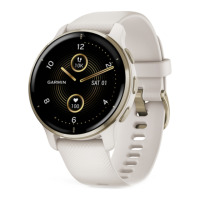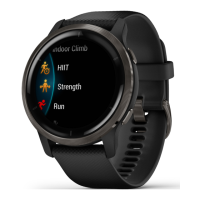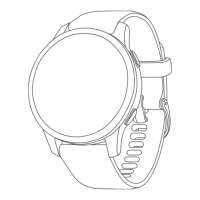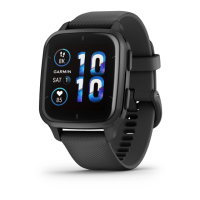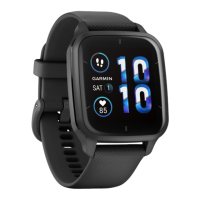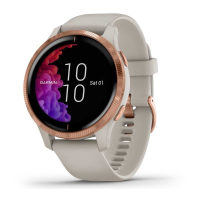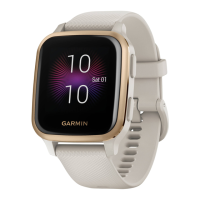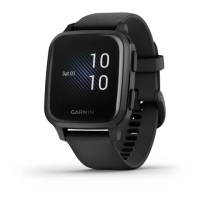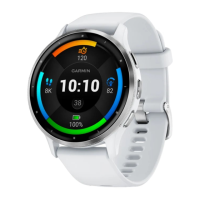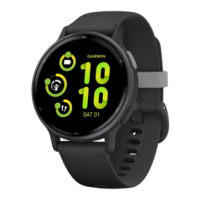Do you have a question about the Garmin VENU 2S and is the answer not in the manual?
Details the physical components and buttons of the Venu 2/2S device.
Guides on using the touchscreen and essential device controls for navigation and interaction.
Explains the meaning of various icons displayed on the device for status and features.
Instructions for pairing the device with a smartphone and setting up Wi-Fi and Bluetooth connections.
Managing phone notifications, text replies, and incoming calls on the Venu 2/2S.
How to download and customize watch faces, data fields, and apps from Connect IQ.
Steps to download personal audio or connect to third-party providers for music playback.
How to listen to music, connect headphones, and control playback on the Venu 2/2S.
Adding, managing, and suspending credit or debit cards in the Garmin Pay wallet.
Instructions on how to use the Venu 2/2S to make contactless payments.
Guide to changing or resetting the Garmin Pay passcode for security.
Setting up incident detection and requesting assistance for emergencies.
Enabling LiveTrack to share real-time activity data with friends and family.
Adding and managing emergency contacts for safety features.
Information on the wrist heart rate monitor, wearing the device, and data accuracy tips.
Understanding heart rate zones, setting them, and estimating VO2 Max for fitness assessment.
Using the pulse oximeter to measure blood oxygen saturation and its tracking modes.
Overview of Auto Goal, Move Alert, and Sleep Tracking functionalities.
Earning intensity minutes and managing pulse oximeter readings for health insights.
Description of important glances like Body Battery, Calendar, Heart Rate, and Intensity Minutes.
Monitoring Body Battery levels, stress, and heart rate variability for overall wellness.
Features for tracking menstrual cycles and pregnancy for women's health.
Tips and methods for tracking daily fluid intake and hydration goals.
Starting, stopping, and customizing various activity types like running, cycling, and strength training.
Downloading courses, playing golf, and using features like hazards and scoring.
Setting up user profile, using workouts, and following training plans from Garmin Connect.
Saving, deleting, and navigating to specific locations using the device's GPS.
Using the compass and stopping navigation during activities.
Uploading and managing activity data via the Garmin Connect app and computer.
Tracking daily progress, sharing activities, and managing device settings.
Changing, creating, and editing watch faces to personalize the device's appearance.
Customizing the controls menu and setting up shortcut controls for quick access.
Adjusting settings for preloaded activities and apps to enhance functionality.
Managing phone connectivity, Bluetooth status, and smart notifications.
Optimizing battery life using the Battery Saver and understanding battery estimates.
Adjusting display brightness, timeout, time format, and time source.
Customizing measurement units and configuring activity data recording modes.
Various methods to extend the device's battery life, including feature adjustments.
Troubleshooting steps for restarting the device or restoring it to default settings.
Steps to acquire satellite signals for GPS functionality, especially in open areas.
Tips to enhance GPS satellite signal reception and accuracy.
Troubleshooting tips for inaccurate step counting on the device.
Understanding why floors climbed may be inaccurate and how to improve it.
Details the physical components and buttons of the Venu 2/2S device.
Guides on using the touchscreen and essential device controls for navigation and interaction.
Explains the meaning of various icons displayed on the device for status and features.
Instructions for pairing the device with a smartphone and setting up Wi-Fi and Bluetooth connections.
Managing phone notifications, text replies, and incoming calls on the Venu 2/2S.
How to download and customize watch faces, data fields, and apps from Connect IQ.
Steps to download personal audio or connect to third-party providers for music playback.
How to listen to music, connect headphones, and control playback on the Venu 2/2S.
Adding, managing, and suspending credit or debit cards in the Garmin Pay wallet.
Instructions on how to use the Venu 2/2S to make contactless payments.
Guide to changing or resetting the Garmin Pay passcode for security.
Setting up incident detection and requesting assistance for emergencies.
Enabling LiveTrack to share real-time activity data with friends and family.
Adding and managing emergency contacts for safety features.
Information on the wrist heart rate monitor, wearing the device, and data accuracy tips.
Understanding heart rate zones, setting them, and estimating VO2 Max for fitness assessment.
Using the pulse oximeter to measure blood oxygen saturation and its tracking modes.
Overview of Auto Goal, Move Alert, and Sleep Tracking functionalities.
Earning intensity minutes and managing pulse oximeter readings for health insights.
Description of important glances like Body Battery, Calendar, Heart Rate, and Intensity Minutes.
Monitoring Body Battery levels, stress, and heart rate variability for overall wellness.
Features for tracking menstrual cycles and pregnancy for women's health.
Tips and methods for tracking daily fluid intake and hydration goals.
Starting, stopping, and customizing various activity types like running, cycling, and strength training.
Downloading courses, playing golf, and using features like hazards and scoring.
Setting up user profile, using workouts, and following training plans from Garmin Connect.
Saving, deleting, and navigating to specific locations using the device's GPS.
Using the compass and stopping navigation during activities.
Uploading and managing activity data via the Garmin Connect app and computer.
Tracking daily progress, sharing activities, and managing device settings.
Changing, creating, and editing watch faces to personalize the device's appearance.
Customizing the controls menu and setting up shortcut controls for quick access.
Adjusting settings for preloaded activities and apps to enhance functionality.
Managing phone connectivity, Bluetooth status, and smart notifications.
Optimizing battery life using the Battery Saver and understanding battery estimates.
Adjusting display brightness, timeout, time format, and time source.
Customizing measurement units and configuring activity data recording modes.
Various methods to extend the device's battery life, including feature adjustments.
Troubleshooting steps for restarting the device or restoring it to default settings.
Steps to acquire satellite signals for GPS functionality, especially in open areas.
Tips to enhance GPS satellite signal reception and accuracy.
Troubleshooting tips for inaccurate step counting on the device.
Understanding why floors climbed may be inaccurate and how to improve it.
| Display type | Digital |
|---|---|
| Display diagonal | 1.1 \ |
| Watch glass type | Corning Gorilla Glass 3 |
| Display resolution | 360 x 360 pixels |
| Display technology | AMOLED |
| Shape | Round |
| Band size | - |
| Band color | Sand |
| Closure type | Single prong strap buckle |
| Band material | Silicone |
| Watch case size | 40 mm |
| Suggested gender | Female |
| Watch case color | Gold |
| Water resistance | 5 ATM |
| Wrist size range | 110 - 175 mm |
| Market positioning | Smartwatch |
| Protection features | Waterproof |
| Watch case material | Carbon fiber Reinforced Polymer (CFRP) |
| Built-in microphone | No |
| Mobile operating systems supported | Android, iOS |
| Heart rate measuring | Automatic |
| Battery capacity | - mAh |
| Battery life (max) | 264 h |
| Battery life (GPS mode) | 19 h |
| Width | 40.4 mm |
|---|---|
| Weight | 38.2 g |
| Thickness | 12.1 mm |
